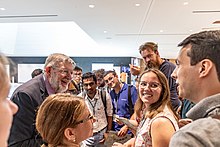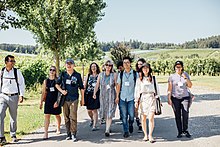Meeting of the Nobel Laureates in Lindau
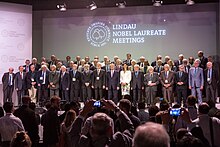
The Lindau Nobel Laureate Meetings (English: Lindau Nobel Laureate Meetings ) are annual scientific conferences since 1951 in the town of Lindau (Bodensee) take place. Its aim is to bring Nobel Prize winners and young scientists together in order to promote scientific exchange across generations, cultures and disciplines.
aims
Every Lindau Nobel Laureate Meeting consists of a large number of scientific program items such as plenary lectures and panel discussions as well as various networking and community events. The meetings have a special place among the international science conferences: With an average of 30-40 participating laureates per year, they represent the world's largest gathering of Nobel Prize winners outside of the award ceremony in Stockholm. The meetings are not about the presentation of new research results, but rather, it is about the exchange of ideas and the discussion of topics that have global relevance for all scientists. The Nobel Prize winners do not receive a fee for their performances and are completely free to choose their lecture topics. Around 350 of them are members of the meeting of founders for the conferences.
The goals of the conferences are not only to promote the transfer of knowledge between laureates and young scientists, but also to promote the exchange of knowledge within the international scientific community and with the rest of society. This project is referred to by the board of trustees for the Lindau Nobel Laureate Meetings as "Mission Education". To give the young scientists the opportunity to build global networks - e.g. B. via the Lindau Alumni Network - is also part of the endeavors of the conferences. Their slogan is "Educate, Inspire, Connect."
history
After World War II, Germany suffered from the aftermath of the Nazi regime and, as a result, was largely excluded from international science. During this time, there were hardly any important science conferences in Germany.
Idea & foundation (1951)
The two Lindau doctors Franz Karl Hein and Gustav Wilhelm Parade had the idea in 1949 to bring German doctors and researchers together with Nobel Prize winners. They convinced Count Lennart Bernadotte af Wisborg , member of the Swedish royal family and owner of the nearby island of Mainau , to assert his good relations with the Swedish Nobel Committee and to support the project. The first conference in 1951 was devoted to the fields of medicine and physiology and was attended by seven Nobel Prize winners; including Adolf Butenandt and Hans von Euler-Chelpin . After the success of the first Nobel Laureate Meeting, the scientific focus was increased and the two other Nobel Prize disciplines in the natural sciences, chemistry and physics, were added to the program. In the following years a mode was established in which the main discipline of the conference changes annually. Since 2000, an interdisciplinary conference has been held every five years at which the three natural sciences are combined.
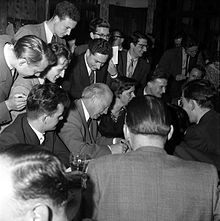
1954-2000
In 1954 the board of trustees for the Lindau Nobel Laureate Meetings was established and from then on served as the organizing committee for the meetings. Count Lennart Bernadotte was appointed its first president. The concept of inviting young scientists to the conferences was also born this year. This step was intended to increase the social added value of the event. In 1954, even some students from the GDR were able to take part in the Nobel Laureate Meeting.
What von Hein and Parade had initially envisaged as a European science conference, gradually developed into an international event. In the early years of the conferences only students from the countries bordering Lake Constance took part, but year after year other countries began to send representatives. Since the year 2000, young scientists from 80 to 90 different countries have taken part in every Nobel Laureate Meeting.
In 1987, Count Bernadotte resigned from his position as President of the Board of Trustees for health reasons and his wife, Countess Sonja Bernadotte af Wisborg , took over the position.
2000-2008
Shortly before the turn of the millennium, there were concerns about the continuation of the conferences, as their future funding was not secured. In order to counter this negative development, Countess Bernadotte expanded the board of trustees to include experts from the fields of charitable foundations and public relations, as well as representatives from the Stockholm Nobel Foundation .
Two major goals under Countess Sonja Bernadotte's aegis were to further advance the internationalization of the conferences and to improve their public image.
On the occasion of the 50th Lindau Nobel Laureate Meeting in 2000, the establishment of the Lindau Nobel Laureate Meeting Foundation was announced. This was to secure the financing of the conferences from now on. When it was founded, over 40 Nobel Prize winners joined the Foundation's founders' meeting (there are now around 350) in order to support the conferences with ideas and finances.
2008 - today
When Countess Sonja Bernadotte died in October 2008, her daughter, Countess Bettina Bernadotte af Wisborg , was elected President of the Board of Trustees. She continued her mother's course and worked steadily on expanding the international network of scientific partner institutions, adding a great commitment to education and increasing the social added value of the conferences.
Meetings
Since its inception in 1951, the Lindau Nobel Laureate Meetings have always taken place in the Lake Constance city of Lindau, the city center of which is located on an island in the lake that is connected to the mainland by bridges .
Conference cycle
Each year, the Nobel Laureate Meetings are dedicated to one of the scientific Nobel Prize disciplines medicine or physiology, chemistry and physics. Since the year 2000, an interdisciplinary conference has been held every five years (most recently in 2015) to which representatives of all disciplines are invited. In addition, the Lindau Conference on Economics has been held every three years since 2004 and is dedicated to the winners of the Alfred Nobel Memorial Prize for Economics (“Nobel Economics Prize”).
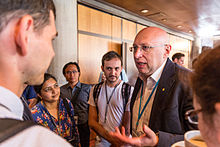
scientific programme
The following program formats are currently used at the Lindau Nobel Laureate Meetings:
Lectures: Classical lectures in which the Nobel Prize winners are completely free to choose a topic.
Agora Talks : This format, which was introduced in 2018, combines an interview or part of a discussion with a question-and-answer session and offers space for a lot of exchange. The format is particularly suitable for controversial and current topics.
Discussion Sessions: In the afternoon after their lectures, the Nobel Prize winners will answer questions from the students in a closed group.
Master Classes: After applying in advance, young scientists get the chance to present their own research in front of a selected audience and to receive feedback from the laureates.
Panel Discussions: These public panel discussions are dedicated to the big, topical issues in science. The field of participants usually consists of laureates, young scientists, but also representatives from politics, business and the media.
Science breakfasts: early morning discussion events organized by partner organizations or sponsors.
There are also other formats such as poster sessions, science walks, laureate lunches and life lectures.
Supporting program
The Lindau Nobel Laureate Meetings also have a wide-ranging supporting program, which is intended primarily for networking and getting to know each other, including dinners, barbecues and cultural events. Since 2009, a so-called “International Day” has been part of every conference, the evening event of which is always hosted by a host country. Previous host countries have been: India (2009), the European Union (2010), the United States (2011), Singapore (2012), South Korea (2013), Australia (2014), France (2015), Austria (2016), Mexico ( 2017), China (2018) and South Africa (2019).
Boat trip to the island of Mainau
The final trip of each conference combines a scientific and leisure program with an excursion to the island of Mainau. The visit to the island of the Bernadotte family also serves to hold another large panel discussion (mostly on socially relevant topics), but at the same time to allow students from all over the world to participate in the attraction of the "flower island".

Attendees
As a rule, 30 to 40 Nobel Prize winners and 500–600 young scientists from around 80 countries take part in conferences devoted to a single discipline. There are also various guests of honor from politics, business and academia as well as representatives of the international media.
Application process
Young scientists who want to take part in the conferences must first go through a multi-stage selection process. Students, doctoral candidates and post-docs under 35 who are among the best in their year and who do not yet have a permanent position can apply. Young scientists can only participate once in a Lindau Nobel Laureate Meeting.
Special guests
Over the years, many notable personalities have attended the Lindau Nobel Laureate Meetings, including the former German Federal Presidents Roman Herzog , Johannes Rau , Horst Köhler , Christian Wulff and Joachim Gauck , who gave the opening speech at the interdisciplinary conference in 2015. Federal Chancellor Angela Merkel opened the business conference in 2014 and in 2017 the then President of the ECB Mario Draghi .
Other special guests included software pioneer and philanthropist Bill Gates , the former President of the European Commission José Manuel Barroso and the President of Singapore, Tony Tan .
organization
The Lindau Nobel Laureate Meetings consist of two legal bodies - the Board of Trustees and the Foundation. While the Board of Trustees is responsible for the design of the scientific program and, with the help of its executive secretariat, for the implementation of the conferences, the task of the foundation is to secure the financing of the conferences.
Academic partners
The Board of Trustees maintains a global network of academic partner institutions, which range from national science academies, universities and foundations to government ministries. Applications for participation in the Nobel Laureate Meetings must be sent to the respective academic partners, who in turn nominate the best young scientists for participation.
financing
The Lindau conferences are financed by both public funds and private grants. The costs of each conference are made transparent in the freely available annual reports. Private donors and sponsors are named both on the organization's website and in other publications.
effect
Since its inception, the aim of the Lindau Nobel Laureate Meetings has been to create an atmosphere in which scientists can take on greater social responsibility. Several political appeals arose in the history of the conferences.
The impact of the conferences on the 35,000 or so students who have participated in around 70 years is difficult to measure and yet profound. One sponsor of the conferences put it as follows: “When you leave Lindau again, the motivation and inspiration that will be retained over the years can be seen in the eyes of the young researchers! ".
Global networks
The conferences offer plenty of networking opportunities for the young scientists who make close contacts in Lindau, which later often lead to scientific collaborations and an intensive transfer of knowledge across the borders of different cultures. The Lindau Alumni Network and regular events for alumni help to network the Lindau community even after the conferences.
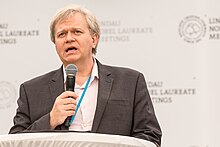
Mainauer declarations
See also: Mainauer Declaration
In 1955, on the occasion of the fifth Lindau Nobel Laureate Meeting, the two German Nobel laureates in physics, Max Born and Otto Hahn , initiated the “Mainau Declaration” against the use of nuclear weapons , which was aimed at those in power around the world at the time and was intended to prevent them from using nuclear weapons. The declaration was signed by 18 laureates attending the conference, and within a year the number of signatures rose to 52.
Sixty years later, at the 65th Lindau Nobel Laureate Meeting in 2015, the Nobel Laureates turned to the public with a second Mainau Declaration. The “Mainau Declaration 2015 on Climate Change” called on politicians to commit themselves more strongly to climate protection . 36 of the participating Nobel Prize winners signed the declaration on site, 35 more were added later.
In the tradition of the “Mainau Declarations”, Nobel Prize winner Elizabeth Blackburn initiated the “Lindau Guidelines” in her opening speech at the 68th Lindau Nobel Laureate Meeting, which formulate guidelines for global, sustainable, cooperative and open science in the 21st century. The Lindau Guidelines currently comprise 10 goals that are currently still openly discussed and are to be officially adopted and signed at the 70th Lindau Nobel Laureate Meeting in 2021.
Media library
To make the long tradition and history of the Lindau Nobel Laureate Meetings better known, a digital, publicly accessible archive was set up. The media library currently contains over 400 hours of video material from lectures by the Nobel Prize winners from Lindau. In addition, photos, animated learning films and interactive content such as virtual laboratory tours and interactive maps are available.
The media library is also designed as an educational tool and contains various thematic dossiers in the form of teaching materials that introduce specific areas of science with the help of research by the Nobel Prize winners.
other projects
The Lindau Nobel Laureate Meetings are actively involved in science communication through many other projects in accordance with the leitmotif of their "Mission Education". Among them, for example, the photo exhibition “Sketches of Science” by the science photographer Volker Steger , which has already been shown in many places around the world, and a permanent exhibition on the history of the conferences in the Lindau City Museum. Additional educational content is also produced in collaboration with the Nature Publishing Group .
For the first time in its almost 70-year history, the meetings planned for 2020 had to be postponed to the following year due to the global corona pandemic. Instead, Nobel Prize winners, Lindau alumni and young scientists came together online and exchanged virtual experiences at the Online Science Days 2020 and the Online Sciathon 2020.
Web links
- Lindau Nobel Laureate Meetings - Website
- Mediathek - free multimedia archive with Nobel Laureate lectures
Individual evidence
- ^ Lindau Nobel Laureate Meetings, website. In: Founders Assembly. Lindau Nobel Laureate Meetings, accessed June 14, 2020 .
- ↑ Ralph Burmester: Science at first hand . Ed .: Deutsches Museum Bonn. Bonn, Germany 2015, p. 42 ff .
- ↑ Ralph Burmester: Science at first hand . Ed .: Deutsches Museum Bonn. Bonn, Germany 2015, p. 72/73 .
- ↑ Ralph Burmester: Science at first hand . Ed .: Deutsches Museum Bonn. Bonn, Germany 2015, p. 86 ff .
- ↑ Ralph Burmester: Science at first hand . Ed .: Deutsches Museum Bonn. Bonn, Germany 2015, p. 138 .
- ^ Lindau Nobel Laureate Meetings, website. In: Meetings. Lindau Nobel Laureate Meetings, accessed June 14, 2020 .
- ^ Lindau Nobel Laureate Meetings, website. In: Selection Criteria 2016. Lindau Nobel Laureate Meetings, accessed June 14, 2020 .
- ^ Lindau Nobel Laureate Meetings, website. In: Publications. Lindau Nobel Laureate Meetings, accessed June 14, 2020 .
- ^ Lindau Alumni Network, website. In: Publications. Lindau Nobel Laureate Meetings, accessed June 14, 2020 .
- ^ Lindau Alumni Network, website. In: Publications. Lindau Nobel Laureate Meetings, accessed June 14, 2020 .
- ^ Lindau Guidelines, website. In: Publications. Lindau Nobel Laureate Meetings, accessed June 14, 2020 .
- ↑ Online Science Days 2020, website. In: Publications. Lindau Nobel Laureate Meetings, accessed June 14, 2020 .
- ↑ Online Sciathon 2020, website. In: Publications. Lindau Nobel Laureate Meetings, accessed June 14, 2020 .
